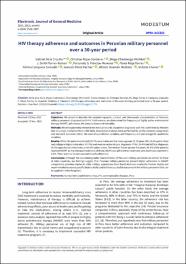| dc.contributor.author | De la Cruz Ku, Gabriel | es_ES |
| dc.contributor.author | Rojas Contreras, Christian | es_ES |
| dc.contributor.author | Chambergo-Michilot, Diego | es_ES |
| dc.contributor.author | Torres-Roman, J. Smith | es_ES |
| dc.contributor.author | Príncipe-Meneses, Fortunato S. | es_ES |
| dc.contributor.author | Rioja Torres, Flavia | es_ES |
| dc.contributor.author | Campana Zamudio, Fátima | es_ES |
| dc.contributor.author | Pérez Pachas, Gonzalo | es_ES |
| dc.contributor.author | Huamán Modesto, Alfredo | es_ES |
| dc.contributor.author | Chavez, Victoria | es_ES |
| dc.date.accessioned | 2023-03-16T18:58:42Z | |
| dc.date.available | 2023-03-16T18:58:42Z | |
| dc.date.issued | 2022-11-27 | |
| dc.identifier.uri | https://hdl.handle.net/20.500.13053/8121 | |
| dc.description.abstract | “Objectives: We aimed to describe the sociodemographic, clinical, and therapeutic characteristics of Peruvian military personnel diagnosed with HIV. Furthermore, we determined the frequency of highly active antiretroviral therapy (HAART) adherence, the complications and mortality.
Methods: We retrospectively reviewed the medical records of patients diagnosed with HIV, confirmed by Western
blot at a single institution from 1989-2020. Descriptive analyses were performed for all the variables using mean
and standard deviation (SD) in the case of quantitative variables, and frequency and percentage for qualitative
variables.
Results:Ofthe 161 patients included, 95.7% were males and the mean age was 39.59 years (SD= 16.45 years). Most had college or higher education (67.7%) and were on active duty at diagnosis (77%). 35.4% had AIDS at diagnosis;
28.6% opportunistic infections; and 8.1% tuberculosis. The median follow-up was five years. 94.4% of the patients received HAART as the principal treatment; of these, 88.8% was adherent to treatment, and death was reported in 6.8%. There were no factors associated with adherence.
Conclusions: Although the sociodemographic characteristics of Peruvian military personnel are similar to those
of other countries, our findings suggest that Peruvian military personnel present higher adherence to HAART compared to previous studies in other military populations from South American countries. Further studies are recommended to assess specific factors attributed to these successful outcomes in the military personnelthat can be applied in other hospitals“ | es_ES |
| dc.format | application/pdf | es_ES |
| dc.language.iso | eng | es_ES |
| dc.publisher | Modestum LTD | es_ES |
| dc.rights | info:eu-repo/semantics/openAccess | es_ES |
| dc.rights.uri | https://creativecommons.org/licenses/by/4.0/ | es_ES |
| dc.subject | human immunodeficiency virus, HIV, communicable diseases, Peru | es_ES |
| dc.title | “HIV therapy adherence and outcomes in Peruvian military personnel over a 30-year period“ | es_ES |
| dc.type | info:eu-repo/semantics/article | es_ES |
| dc.identifier.doi | https://doi.org/10.29333/ejgm/12776 | es_ES |
| dc.type.version | info:eu-repo/semantics/publishedVersion | es_ES |
| dc.publisher.country | GB | es_ES |
| dc.subject.ocde | http://purl.org/pe-repo/ocde/ford#3.03.00 | es_ES |


